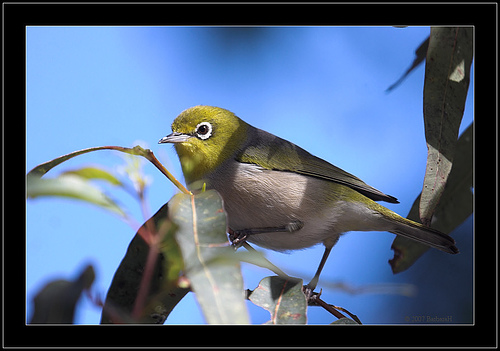Many vineyards in the Margaret River region have completed a final trim of the vines to present the canopy in the best possible condition to ripen fruit and to facilitate the application of nets that will protect the fruit from the damage that birds can inflict.
There are a few species of birds that have a passion for the ripest berries. Crows, parrots and Wattle birds tend to remove whole grapes from bunches and this results in a reduction in yield. The Silvereye, a small olive green bird, about the size of a wren and with silver/white markings around the eyes that resemble a bandit’s mask, can wreak havoc within a vineyard. The Silvereye can detect the ripest fruit and will fly in from surrounding bush to access grapes. Unfortunately for the Silvereye it has a pointed beak better at accessing nectar and eating small insects than eating grapes, so at best the beak can only stab at berries. After the berry is stabbed the bird then removes the beak from the berry, licks the beak with its tongue to take in the small amount of sweet juice and then repeats the process on another berry. In studies conducted on the metabolism and calorific requirements of the Silvereye, it was determined that the energy used in flying to the vineyard could not be met by the calorific value gained by eating the grape and therefore the Silvereyes are becoming more desperate. The bird emits a high frequency feeding call that can be relayed kilometres by other Silvereyes and the population migrates to the food source and hence a lot of damage can happen in a short period of time. Damaged berries then become susceptible to further damage from moulds and yeast, this then completely ruins any remaining whole berries. Many different methods of control have been trialled over many years. The best solution is to net the prone areas and to exclude the Silvereyes completely.
Sampling of fruit as a lead into vintage is conducted by both vigneron and winemakers alike. A representative sample of bunches is collected from the vineyard and is assessed for sugar content (expressed as Baume or Brix), pH and Titratable Acidity. These results give some indication to the ripeness of the fruit. The most important method of assessing fruit for harvest is to taste it and appreciate the potential that will be in the end wine. Many berries are tasted out in the vineyard and this would appear to be a simple task that resembles just eating a few grapes. We need to understand that the process of tasting fruit in the vineyard has to be done to best represent the total crop, so please don’t just eat the sun exposed ripe grapes. The taster will select berries from the top, bottom, sides, middle and rear of bunches. The flavour of the juice on cracking the berry in the mouth with the tongue will be savoured. The pulp is then removed from the berry with the tongue and the freeness of seed from pulp assessed. The seeds are then examined for green colour and then if deemed to be ripe enough are chewed and assessed for crunchiness and flavour. The skins are then chewed and assessed for texture, mouth feel (tannin dryness) and flavour. The skins are then removed from the mouth and assessed between the finger and thumb for free colour expression. This will occur many times throughout a block of vines to form an assessment of the potential for harvest and fruit quality. Such is the lot of a grape taster.
This vintage we have lighter crops in many vineyards and have had a warm period through January and February which has resulted in hastening physiologic ripeness in red varieties. It is interesting to note that many growers are seeing ripe fruit characters in reds before normal Baume are reached. This is quite common and is why we need to look at berry sensory analysis as a means of assessing ripeness and not just assessing ripeness in the laboratory. This week I have seen many Cabernet Sauvignon crops in northern Margaret River that are very close to harvest and yet the Lab results don’t indicate this.
Contributed by Bruce Pearce

About Margaret River Discovery Tours
Sean Blocksidge is the owner operator of the Margaret River Discovery Company, an avid photographer, blogger and South West WA ambassador. In 2010 he won Western Australian Guide of the Year and his tours have been rated the #1 thing to do in Australia on the Tripadvisor website for the past two years.


